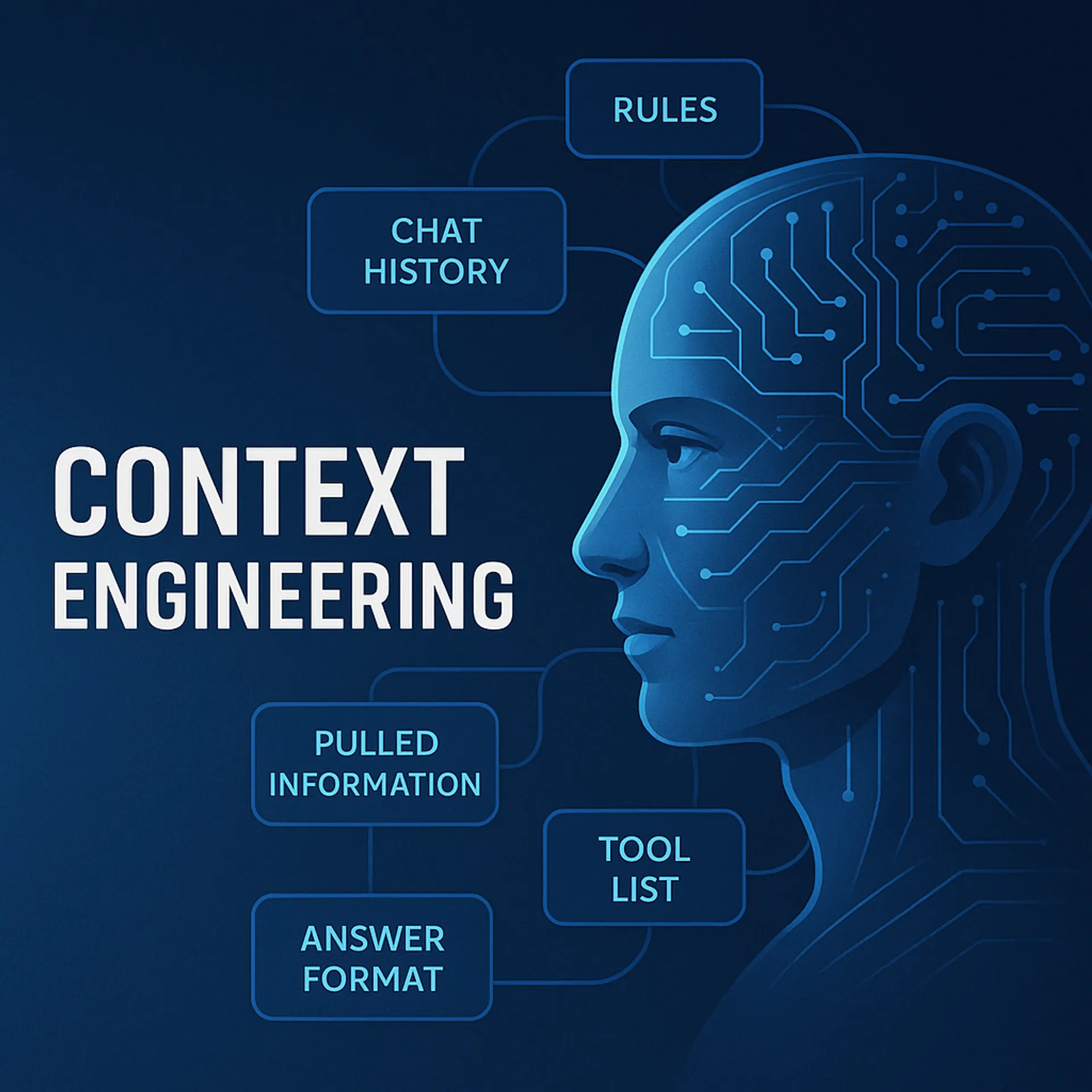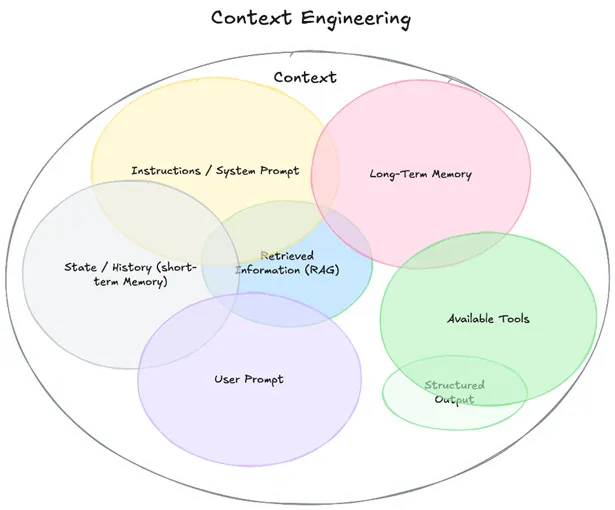
What Is Context Engineering? Boost Your AI with Better Context
Learn what Context Engineering is, how it differs from Prompt Engineering, and see real-world examples like AI coding assistants. A simple guide for beginners to understand how AI truly becomes smart.
Introduction
In the fast-moving world of AI, new ideas pop up all the time. You might have heard of “Prompt Engineering.” But there’s a bigger, more powerful idea gaining attention: Context Engineering. If you’re new to AI and want to know how it really works, understanding context engineering is key.
What is Context Engineering?
Imagine talking to a really smart friend. They understand you best when they know your past talks, what you like, and what you’re trying to do, right?
Context Engineering involves carefully designing, building, and managing all the information an AI model sees and uses to generate a response. Think of the model as a brilliant but forgetful student. If you give only one instruction, its answer may be generic. But if you provide notes, relevant textbooks, past dialogues, and personal preferences, the response becomes accurate, personalized, and insightful.
The “context window” can include:
- Rules: How the AI should act or what kind of answers to give.
- Chat History: What you’ve talked about before, so it remembers.
- Pulled Information: Facts from documents, notes, or other knowledge sources.
- Your Details: Things about you, like your preferences or style.
- Tool List: What outside tools (like a calculator or calendar) the AI can use.
- Answer Format: How the AI should shape its reply (e.g., a list, a paragraph).
The main goal is to make sure the AI has all the right, organized information at the right moment to do big tasks on its own and do them well.
 This diagram illustrates how Context Engineering brings together multiple information streams to guide AI responses.
This diagram illustrates how Context Engineering brings together multiple information streams to guide AI responses.
Prompt Engineering vs. Context Engineering
Although related, these two approaches differ significantly:
-
Prompt Engineering: This focuses on crafting the immediate, single instruction or question you give to an AI model to get a desired response. It’s about what you say to the model. For instance, writing a perfect query to get a specific type of poem or a short piece of code. You can learn more about prompt engineering here.
-
Context Engineering: This takes a broader, systems-level approach. It’s about designing the entire information ecosystem around the AI, ensuring it has all the background knowledge, memory, and tools to respond effectively across multiple interactions, tasks, and users. It’s about what the model knows when you say something.
Real‑World Examples of Context Engineering
Context Engineering is quietly working behind the scenes in many advanced AI tools we use every day:
-
Customer Service Bots: A smart customer service AI doesn’t just answer one question at a time. It uses information like your past support tickets, account details, shopping history, and product manuals. This helps it give you personal and correct answers, remembering what’s happened before.
-
AI Coding Assistants (like Cursor, GitHub Copilot): This is a perfect example of context engineering in action. When you use an AI code editor or helper, it’s not just guessing what code to write next. It uses a lot of “context,” which includes:
- The words in all your open code files: If you have
main.py,utils.py, andconfig.jsonopen, the AI uses all their content. - Your whole project’s structure: It understands how your files and folders are set up.
- Recent changes and history: It knows what you’ve recently changed in your code.
- Your own coding style: It learns how you like to write code.
- Helpful documents or libraries: Some tools can even pull in outside instructions.
For example, if you’re writing a new function in
user_profile.pythat needs to get data using a tool fromapi_client.pyand save it using a helper fromdb_utils.py, the AI “reads” all these important files. Then, it suggests function names, variable names, and even whole blocks of code that fit perfectly with your project’s logic and style. It can do this because you, or the editor, have given the AI the context of your entire code project. It’s like having a skilled programmer next to you who knows your whole project inside and out! - The words in all your open code files: If you have
-
Personalized Financial Advisors: An AI financial advisor can give you custom advice because it has access to all your investments, knows how much risk you’re okay with, and sees real-time market numbers. This helps it give very useful recommendations.
Why Context Engineering Matters
AI apps are becoming more complex. Simple questions aren’t enough for tasks that need AI to:
- Remember things: AI needs to recall past conversations and your specific information.
- Know outside info: AI models must get updated facts that weren’t in their original training.
- Use tools: AI programs need to know when and how to use outside tools (like calendars or databases).
- Be reliable: For real programs, AI answers need to be correct and useful consistently.
Context Engineering makes sure AI models are not just “smart,” but “aware” and can think deeply and act on their own.
How to Implement Context Engineering
Context Engineering is more about designing a system than finding a quick trick. Here are the main parts and best ways to do it:
- Set the AI’s Job and Goal: Clearly tell the AI who it is, what its mission is, and what results you expect. This sets its basic “rules.”
- Give it Key Information (RAG): Use a system called Retrieval-Augmented Generation (RAG). This means:
- Vector Databases: Storing your documents, user data, and other knowledge in a way that AI can search quickly.
- Retrieval Tools: Creating ways for the system to find and bring out the most important bits of information based on your question and the current situation.
- Manage Chat History and Memory:
- Short-Term Memory: Keep track of the recent parts of your conversation.
- Long-Term Memory: Store your preferences, past actions, or things the AI learned that stay even after you close the chat. Simple summaries can help manage how much information the AI can handle at once.
- Add Tools and APIs: Give the AI descriptions and access to outside tools (like a weather app or a booking system). Show the AI how to use what the tools give back in its answers.
- Organize and Prioritize Context: The order and how information is given to the AI matters. Important things (like the main task) should often be put closer to the end of the information the AI sees. Ways to do this include:
- Breaking into Chunks: Splitting large documents into smaller, easier-to-read parts.
- Summarizing: Making information shorter to fit limits, but keeping important details.
- Using Templates: Keeping a consistent way to set up different types of context (e.g.,
[RULES],[DATA],[YOUR QUESTION]).
- Keep Improving: Context Engineering is a journey, not a one-time thing. Keep testing your AI system, get feedback, and make changes to how you manage context to make it better and faster.
Conclusion
Context Engineering transforms AI from a one‑shot responder into a context‑aware collaborator by supplying the right information at the right time. Mastering this approach ensures your AI applications are accurate, reliable, and truly tailored to user needs.